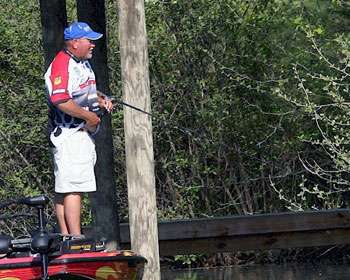
Matt Herren is a rookie on the Bassmaster Elite Series trail, but it's a fallacy to consider him anything other than a veteran tournament competitor. Over the years, he's won tens of thousands of dollars not only from his Alabama cohorts, but from anglers around the country as well. And a sizeable percentage of those funds has been earned with a flipping stick in hand.
Herren is the type of angler who just about salivates when he sees a prime dock at the right time. However, he knows that not all docks are created equal, and that even the best ones can fish differently at different times. "Seasonal patterns and time of the year dictate right off where the fish are going to be," he says. "If it's summertime or fall, the bass like to set up on the corners, particularly anything irregular, like a ladder. In the spring when they're trying to spawn, they really like to get on the back walkways, in 1 to 2 feet of water along the corner poles.
They'll use these just like they would a laydown or a stump, which they like to nest beside. And in summer they use docks for shade and to ambush shad." He also tries to envision the water as if the dock were not there.
That is, what structural elements are there that would draw fish in the absence of the man-made cover? If the right elements aren't in place, he won't waste much time. But once he finds a likely candidate, he'll fish it thoroughly. If there are 20 pilings, "I'll hit 20 of them," he says. "You're looking for shade. Too many times I've gone down one side of a dock and not gotten a bite and then fished the other side, the shady side and caught two or three bass." The way he fishes the docks also varies based on seasonal conditions.
When fish are spawning, they can't use complete darkness, so in the springtime Herren picks more at the edges: "In the spring I'm not so concerned about getting under the structure," he says. "I'm trying to get the bait to fall vertically along the pole.
They spawn at the base of the pole just like they would on a stump. So I'll pitch in just past the target and try to make it fall straight down." Later in the year, he'll often try to get a place in the deepest, darkest portion of the cover, the zones where no lure has gone before. "In the summer or fall I may not concentrate on the poles so much as on the shade under the dock or the brush underneath it," he says. But seasonal patterns are only a guideline, a starting point. It's critical to gauge the attitude of the bass and adjust accordingly.
Each bite is a piece of the puzzle. So when conditions change — particularly for the worse — Herren advises anglers fish fairly fast, to "get a bite, and let it clue you in." On the contrary, when conditions are stable and favorable, "you can slow down because a lot of days they'll position in the same way." "Fish on docks can be easy to pattern," he continues.
"Pay attention to your bites, and you can usually repeat them." While he's most comfortable with a flipping stick in his hand and a jig-and-pig on the line, he'll often go to the opposite extreme if the conditions, or fish, so dictate. Then he'll get out the lighter tackle and a shaky head and go to work.
A spinnerbait and a Reaction Innovations Skinny Dipper soft jerkbait also have their time in the sun, or the shade, as the case may be. And don't dismiss other lure choices, based on local forage or regional differences. "Each lake has its own little quirks," he says.
(Provided by Z3 Media)





